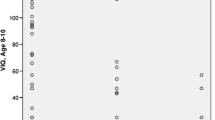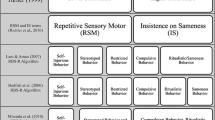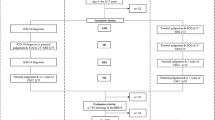Abstract
This study examined whether repetitive behaviours were a differentiating feature of autism in children aged less than 51 months. The study also examined the relationship between age (chronological and developmental) and repetitive behaviours in young children with autism. Standardised developmental and diagnostic assessments were conducted on 55 children aged between 22 and 51 months, consisting of 40 developmentally delayed children with DSM-IV-TR Autistic Disorder and 15 developmentally delayed children without Autistic Disorder. Results indicated that several measures of repetitive behaviour, particularly more complex high-level ones, were significantly positively associated with the probability of receiving a diagnosis of autism. No significant relationships were found between developmental age and the presence of repetitive behaviours in children with autism, but younger chronological age was associated more with simple or low-level repetitive behaviours.
Similar content being viewed by others
References
Adrien JL, Bathelemy C, Perrot A, Roux S, Lenoir P, Hameury L, et al. (1992) Validity and reliability of the infant behavioural summarised evaluation (IBSE): A rating scale for the assessment of young children with autism and developmental disorders. J Autism Dev Disord 22(3):375–394
Adrien JL, Lenoir P, Martineau J, Perrot A, Hameury L, Larmande C, et al. (1993) Blind ratings of early symptoms of autism based upon family home videos. J Am Acad Child Adolesc Psychiatry, 32:617–626
American Psychiatric Association (2000) Diagnostic and Statistical Manual of Mental Disorders—Text Revision 4th edn. Washington, DC: American Psychiatric Association
Bryson SE (1996) Brief report: Epidemiology of autism. J Autism Dev Disord 26(2):165–167
Charman T, Baird G (2002) Practitioner review: Diagnosis of autism spectrum disorder in 2- and 3-year-old children. J Child Psychol Psychiatry 43(3):289–305
Cox A, Klein K, Charman T, Baird G, Baron-Cohen S, Swettenham J, et al. (1999) Autism spectrum disorders at 20 and 42 months of age: Stability of clinical and ADI-R diagnosis. J Child Psychol 40(5):719–732
Dahlgren SO, Gillberg C (1989) Symptoms in the first two years of life: A preliminary population study of infantile autism. Eur Arch Psychiatry Neurol Sci 238:169–174
Einfeld SL, Tonge BJ (2002). Manual for the Developmental Behavioural Checklist: Primary Carer Version (DBC-P) and Teacher Version (DBC-T) 2nd edn. Melbourne: University of New South Wales and Monash University
Evans DW, Leckman JF, Carter A, Reznick JS, Henshaw D, King RA, et al. (1997) Ritual, habit, and perfectionism: The prevalence and development of compulsive-like behaviour in normal young children. Child Dev 68(1):58–68
Frith U (1989) Autism: Explaining the enigma. Oxford: Blackwell
Gesell A (1928) Infancy and human growth. New York: MacMillan
Gray KM, Tonge BJ (2001) Are there early identifying features of autism in infants and preschool children? J Paediatr Child Health 37:221–226
Hoshino Y, Kumashiro H, Yashima Y, Tachibana R, Watanabe M, Furukawa H (1982) Early symptoms of autistic children and its diagnostic significance. Folia Psychiatrica et Neurology Japan, 36(4):367–374
Howlin P, Moore A (1997) Diagnosis in autism: A survey of over 1,200 patients in the UK. J Autism Dev Disord 1:135–162
Lord C (1997) Diagnostic instruments in autism spectrum disorders. In: Cohen DJ, Volkmar FR (eds) Handbook of autism and pervasive developmental disorders. New York: John Wiley and Sons, pp 460–483
Lord C, Rutter M, DiLavore PC, Risi S (1999) Autism Diagnostic Observation Schedule. USA: Western Psychological Services
Lord C, Rutter M, Le Couteur A (1994) Autism Diagnostic Interview-Revised: A revised version of a diagnostic interview for caregivers of individuals with possible pervasive developmental disorders. J Autism Dev Disord 24(5):659–685
Lord C, Storoschuk S, Rutter M, Pickles A (1993) Using the ADI-R to diagnose autism in preschool children. Infant Mental Health Journal 14(3):234–252
Osterling JA, Dawson G, Munson JA (2002) Early recognition of 1-year-old infants with autism spectrum disorder versus mental retardation. Dev Psychopathol 14:239–251
Rogers SJ (1996) Early intervention in autism. J Autism Dev Disord 26(2):243–246
Rutter M (1978) Diagnosis and definitions of childhood autism. J Autism Child Schizophr 8(2):139–161
Rutter M, Le Couteur A, Lord C (2003) Autism Diagnostic Interview-Revised. Los Angeles, CA: Western Psychologist Services
Rutter M, Schopler E (1987) Autism and pervasive developmental disorders: Concepts and diagnostic issues. J Autism Dev Disord 17(2):159–186
Rutter M, Schopler E (1988) Autism and pervasive developmental disorders: Concepts and diagnostic issues. In: Schopler E, Mesibov GB (eds) Diagnosis and assessment in autism. New York: Plenum Press, pp 15–36
Sallustro F, Atwell CW (1978) Body rocking, head banging and head rolling in normal children. J Pediatr 93(4):704–708
Schopler E, Reichler RJ, Bashford A, Lansing MD, Marcus LM (1990) Individualized assessment and treatment for autistic and developmentally disabled children—Volume 1: Psychoeducational Profile—Revised (PEP-R) (Vol. 1). Texas: ProEd
Siegal B, Pliner C, Eschler J, Elliot GR (1988) How children with autism are diagnosed: Difficulties in identification of children with multiple developmental delays. Dev Behav Pediatr 9(4):199–204
Sparrow SS, Balla DA, Cicchetti DV (1984) Vineland Adaptive Behaviour Scales. Circle Pines, MN: American Guidance Services
Stone WL (1997) Autism in infancy and early childhood. In: Cohen DJ, Volkmar FR (eds) Handbook of autism and pervasive developmental disorders. New York: John Wiley and Sons
Stone WL, Hoffman EL, Lewis SE, Ousley OY (1994) Early recognition of autism: Parental reports vs clinical observation. Arch Pediatr Adolesc Med 48:174–179
Stone WL, Lee EB, Ashford L, Brissie J (1999) Can autism be diagnosed accurately in children under 3 years? J Child Psychol Psychiatry 40(2):219–226
Tabachnick BG, Fidell LS (2001) Using multivariate statistics (4th ed.). Boston: Allyn and Bacon
Thelen E (1979) Rhythmical stereotypies in normal human infants. Animal Behaviour 27:699–715
Turner M (1999) Repetitive behaviour in autism:A review of psychological research. J Child Psychol Psychiatry 40(6):839–849
Vig S, Jedrysek E (1999) Autistic features in young children with significant cognitive impairment: Autism or mental retardation? J Autism Dev Disord 29(3):235–248
Vostanis P, Smith B, Corbett J, Sungum-Paliwal R, Edwards A, Gingell K, et al. (1998) Parental concerns of early development in children with autism and related disorders. J Autism Dev Disord 2(3):229–242
Wing L, Gould J (1979) Severe impairments of social interaction and associated abnormalities in children: Epidemiology and classification. J Autism Dev Disord 9(1):11–29
Author information
Authors and Affiliations
Corresponding author
Rights and permissions
About this article
Cite this article
Mooney, E.L., Gray, K.M. & Tonge, B.J. Early features of autism. Europ.Child & Adolescent Psych 15, 12–18 (2006). https://doi.org/10.1007/s00787-006-0499-6
Accepted:
Issue Date:
DOI: https://doi.org/10.1007/s00787-006-0499-6




